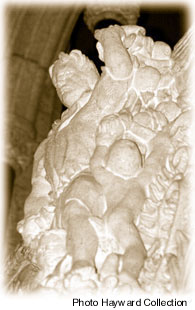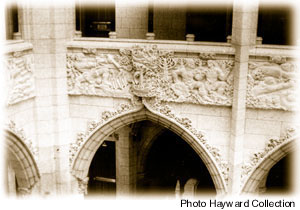 the
History of Canada frieze (1962–1975). Located in the rotunda of the second
floor House of Commons Lobby, the frieze measures 120 feet by four and a
half feet, and consists of twenty blocks. Working
the limestone in some spots to a depth of six inches, Milne demonstrated
her ability to work with architecture and light to achieve compelling images.
the
History of Canada frieze (1962–1975). Located in the rotunda of the second
floor House of Commons Lobby, the frieze measures 120 feet by four and a
half feet, and consists of twenty blocks. Working
the limestone in some spots to a depth of six inches, Milne demonstrated
her ability to work with architecture and light to achieve compelling images.
The blocks were carved on location, requiring scaffolding and ladder work to be done at night. Unable to step back and look at the designs as they were being executed, Milne and her assistants had to be sure to cut the stones correctly the first time. Milne spent eight months studying Canada's history before she undertook designs for the frieze. Given access to documents inside the Parliamentary Library, including diaries, Milne found herself inspired by the history of the people of Canada.
The frieze takes a realistic approach to Canada's history,
 featuring disinterested monarchs, haggard explorers
and even injustices, such as the forced ejection of the Acadians. The families,
children and native peoples shown in the frieze are the positive social
elements. Behind the obvious symbols, Milne has designed deeper messages
about the importance of living in Canada and the freedoms we take for
granted.
featuring disinterested monarchs, haggard explorers
and even injustices, such as the forced ejection of the Acadians. The families,
children and native peoples shown in the frieze are the positive social
elements. Behind the obvious symbols, Milne has designed deeper messages
about the importance of living in Canada and the freedoms we take for
granted.
Having visited Washington D.C., Milne felt that its monuments were lifeless as a result of their monumental size and the remote nature of the sculpture from the human element. She decided to create pieces in the Canadian House of Commons frieze on a human scale to encourage intimacy between the work and the viewer. Eleanor Milne's wish was to communicate to Canadians the importance of leaving conflict behind upon entering Canada. This sentiment is explicitly illustrated on the final panel where doves struggle for flight.